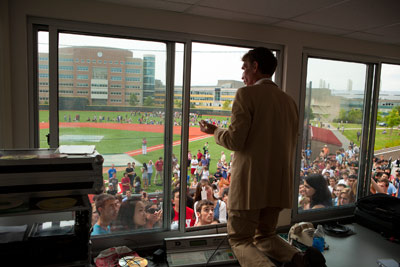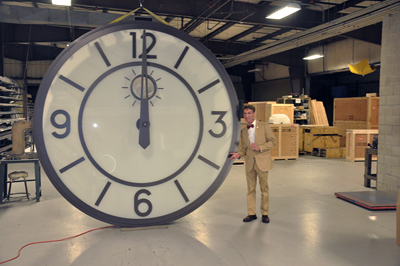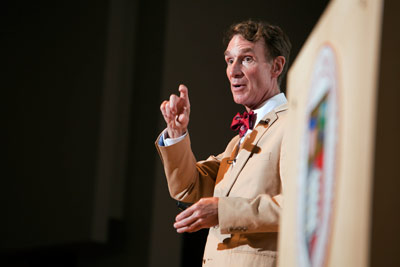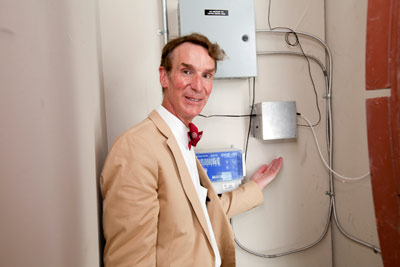Bill Nye '77 harnesses the sun with clock atop Rhodes Hall
By Joe Wilensky






"Look at that -- it's fantastic!" exclaimed Bill Nye '77, as a sun-shaped circle on the face of the new Bill Nye Solar Noon Clock at Rhodes Hall began to glow against a cloudy bright sky. A crowd of hundreds at Hoy Field cheered.
The clock, a gift from Nye to Cornell, was dedicated Aug. 27 following a public lecture that filled the 715-seat Statler Auditorium. Nye talked about his father's passion for sundials and timekeeping, his time at Cornell, his work on the sundials mounted on the Mars rovers and the story behind the Bill Nye Solar Noon Clock.
The Nye-designed clock incorporates a solar noon feature that funnels sunlight into a tube to illuminate a 14-inch disc in the clock face over several minutes each day, marking the sun's passing solar noon -- its highest point in the sky. The controller for the solar noon mechanism was designed by several students of engineering professor Michel Louge.
Solar noon only rarely coincides with actual "clock noon," Nye said. Solar noon in Ithaca Aug. 27 occurred around 1:07 p.m. EDT.
Nye, known to millions as "Bill Nye the Science Guy" from his 1990s PBS TV series, served as a Frank H.T. Rhodes Class of 1956 Professor from 2001-06 and has continued to lecture and make appearances at Cornell. More than a decade ago, as part of Cornell's work on the Mars Exploration Rover project, Nye worked with professors Steve Squyres and Jim Bell to add a sundial feature to the calibration target ("MarsDial") on each rover.
During the lecture, Nye presented a personal look at his lifelong interest in science and sundials.
Nye's mother, Jacquie Jenkins, was recruited along with a dozen of her classmates by the U.S. Navy to work on breaking the Nazi Enigma code. In 1941, Nye's father, Ned Nye, was working for the U.S. Navy on Wake Island and was captured by Japanese forces a few weeks after the attacks on Pearl Harbor. He spent 44 months as a prisoner of war. With his wristwatch confiscated and no electricity, Ned Nye became fascinated with astronomy and sundials and used a broom handle to determine his location and mark the passage of time. He wrote a book and newspaper columns about sundials and instilled a love for astronomy, science and timekeeping in his son.
During a campus visit in the 1990s, Nye noticed that Rhodes Hall -- built after Nye had graduated -- had a prominent, round blank space for an outdoor clock at the top of its façade.
"A clock! That would be cool!" he recalled thinking.
Nye said his lifelong interest in science, sundials and timekeeping inspired him to design a clock that would incorporate a sun-centric feature. He noted that the last line of the message inscribed on each MarsDial reads: "To those who visit here, we wish a safe journey and the joy of discovery."
"That's what we want you to get out of Cornell," Nye said to the many students in attendance. "That's what we want you to do if you are in science or engineering; that's what we want you to do no matter what your discipline is -- to, dare I say it: Change the world!"
Following the lecture Nye led the crowd to Hoy Field and narrated the approach of solar noon from the press box as the crowd watched the clock. Applause and roars accompanied initial brightening of the solar noon indicator and a countdown to actual solar noon a few minutes later.
At a ceremony that morning in Rhodes Hall lobby, Cornell President David Skorton presented Nye with a miniature replica of the Engineering Quad sundial designed by Cornell President Emeritus Dale Corson. Skorton said the Bill Nye Solar Noon Clock joins beauty with science: "It's a very fitting symbol for the creativity, knowledge and skills that flourish on this campus, and which Bill personifies."
Get Cornell news delivered right to your inbox.
Subscribe